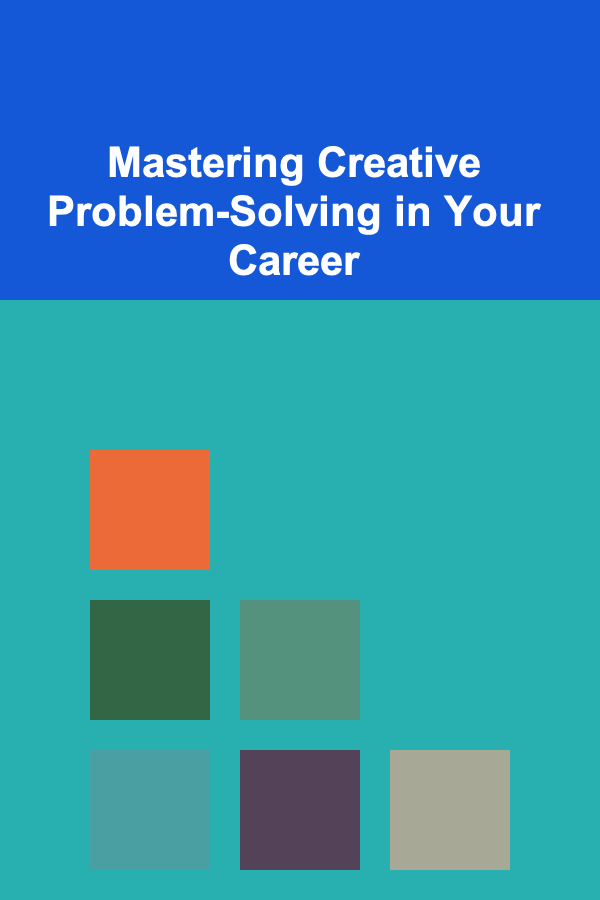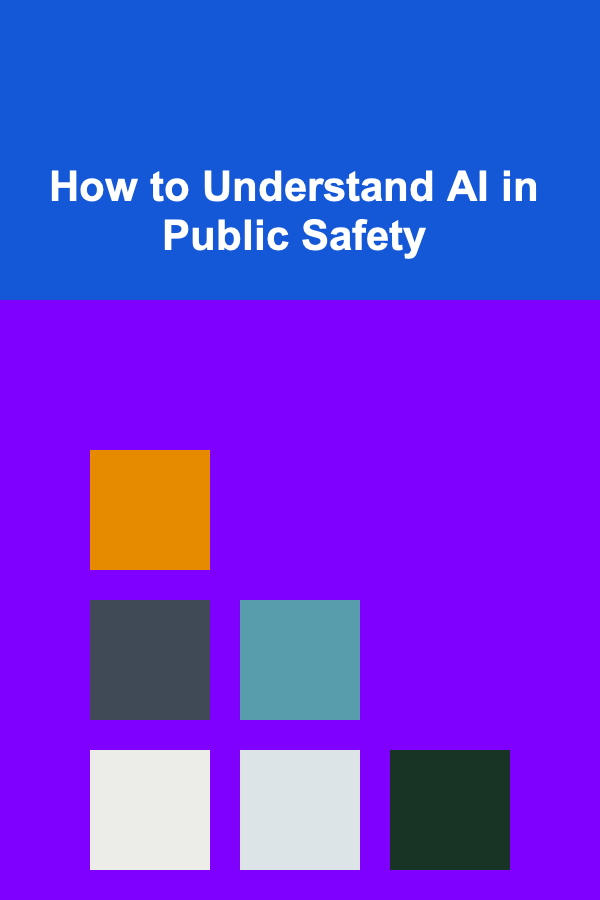
Mastering Creative Problem-Solving in Your Career
ebook include PDF & Audio bundle (Micro Guide)
$12.99$5.99
Limited Time Offer! Order within the next:

In today's rapidly evolving professional landscape, the ability to solve problems creatively is no longer a desirable skill -- it's an essential one. Whether you're a seasoned executive, a budding entrepreneur, or an entry-level employee, mastering creative problem-solving techniques can significantly elevate your career trajectory, making you a more valuable asset to your organization and enabling you to navigate complex challenges with confidence and innovation. This article delves deep into the intricacies of creative problem-solving, exploring its underlying principles, practical strategies, and the mindset shifts required to cultivate this powerful capability.
Understanding Creative Problem-Solving
Creative problem-solving isn't just about coming up with novel ideas; it's a structured approach to identifying, analyzing, and resolving issues in a way that is both effective and innovative. It combines analytical thinking with imaginative thinking, leveraging both to generate solutions that are not only functional but also original and impactful. It's about looking beyond the obvious, challenging assumptions, and exploring unconventional approaches.
Traditional Problem-Solving vs. Creative Problem-Solving: The key difference lies in the process and the outcome. Traditional problem-solving often focuses on applying established methods and known solutions to familiar problems. While efficient, it can be limiting when faced with novel or complex challenges. Creative problem-solving, on the other hand, encourages exploration, experimentation, and the development of new solutions tailored to the specific problem at hand. It embraces ambiguity and uncertainty as opportunities for innovation.
The Benefits of Creative Problem-Solving in Your Career:
- Enhanced Adaptability: In a constantly changing world, the ability to adapt and respond effectively to new challenges is crucial. Creative problem-solving equips you with the tools and mindset to navigate uncertainty and thrive in dynamic environments.
- Improved Innovation: Creative problem-solving is the engine of innovation. By fostering a culture of experimentation and encouraging unconventional thinking, you can generate groundbreaking ideas and solutions that drive progress and create competitive advantage.
- Increased Efficiency and Productivity: Creative solutions can often streamline processes, eliminate bottlenecks, and improve overall efficiency. Thinking outside the box can lead to more effective and less resource-intensive solutions.
- Greater Job Satisfaction: Tackling complex problems creatively can be incredibly rewarding. It fosters a sense of accomplishment and empowers you to make a meaningful contribution to your organization.
- Enhanced Leadership Skills: Creative problem-solvers are often natural leaders. They inspire others to think differently, challenge assumptions, and collaborate effectively to find innovative solutions.
The Creative Problem-Solving Process: A Structured Approach
While creativity may seem like a spontaneous burst of inspiration, effective creative problem-solving follows a structured process. This process helps to channel your creative energy, ensuring that you stay focused, systematic, and ultimately, successful.
- Define the Problem: This is arguably the most critical step. A poorly defined problem will inevitably lead to ineffective solutions. Take the time to thoroughly understand the issue, its root causes, and its impact.
- Ask clarifying questions: "What exactly is the problem?" "What are the symptoms?" "Who is affected?" "When did it start?" "Where is it happening?"
- Gather data: Collect as much relevant information as possible. This might involve research, interviews, surveys, or data analysis.
- Define the problem statement: Formulate a clear and concise statement that accurately reflects the problem you are trying to solve. Avoid vague or ambiguous language. For example, instead of saying "Sales are down," try "Sales of Product X in the Q3 region have decreased by 15% compared to the previous quarter, impacting overall revenue targets."
- Ideate (Generate Ideas): This is the brainstorming phase. The goal is to generate as many potential solutions as possible, without judgment or criticism.
- Brainstorming: Gather a group of people and encourage them to generate ideas freely. Focus on quantity over quality at this stage. Defer judgment until later.
- Mind Mapping: Visually represent the problem and its related concepts using a mind map. This can help you to explore different perspectives and identify connections you might have otherwise missed.
- SCAMPER: A checklist of prompts that can help you to generate new ideas by modifying existing ones. SCAMPER stands for:
- Substitute: What can be replaced?
- Combine: What can be combined with something else?
- Adapt: What can be adapted from something else?
- Modify/Magnify/Minimize: What can be modified, magnified, or minimized?
- Put to other uses: What else can it be used for?
- Eliminate: What can be eliminated?
- Reverse/Rearrange: What can be reversed or rearranged?
- Reverse Brainstorming: Instead of trying to find solutions, try to identify ways to cause the problem. This can help you to understand the underlying factors and generate new ideas for preventing or mitigating the problem.
- Evaluate and Select: Once you have generated a list of potential solutions, it's time to evaluate them and select the most promising ones.
- Develop evaluation criteria: What factors are most important in determining the effectiveness of a solution? This might include cost, feasibility, impact, time to implement, and risk.
- Score the solutions: Rate each solution against the evaluation criteria. This can be done individually or as a group.
- Prioritize the solutions: Based on the scores, prioritize the solutions and select the ones that are most likely to be successful.
- Consider prototyping: Before committing to a full-scale implementation, consider creating a prototype to test the feasibility and effectiveness of the chosen solution.
- Implement: Put the chosen solution into action.
- Develop an action plan: Outline the steps required to implement the solution, including timelines, responsibilities, and resources.
- Communicate effectively: Keep stakeholders informed of the progress of the implementation.
- Manage risk: Identify potential risks and develop contingency plans.
- Evaluate: Assess the effectiveness of the solution after it has been implemented.
- Collect data: Gather data to measure the impact of the solution.
- Analyze the results: Compare the results to the original problem statement.
- Identify lessons learned: What worked well? What could have been done better?
- Adjust as needed: If the solution is not achieving the desired results, make adjustments as needed.
Techniques and Tools for Enhancing Creative Problem-Solving
Beyond the structured process, there are numerous techniques and tools that can enhance your creative problem-solving abilities. These tools help to stimulate your imagination, break down complex problems, and facilitate collaboration.
- Design Thinking: A human-centered approach to problem-solving that emphasizes empathy, experimentation, and iteration. It typically involves five stages: empathize, define, ideate, prototype, and test. Design thinking encourages you to deeply understand the needs and perspectives of the people you are trying to serve.
- Lateral Thinking: A way of thinking that involves breaking away from traditional patterns of thought and exploring new and unconventional perspectives. Edward de Bono, the creator of lateral thinking, developed several techniques, including:
- Random Entry: Introducing a random word or idea into the problem-solving process to spark new associations and perspectives.
- Provocation: Making a deliberately provocative statement to challenge assumptions and stimulate new thinking.
- Concept Fan: Generating a range of possible solutions by systematically exploring different concepts related to the problem.
- TRIZ (Theory of Inventive Problem Solving): A systematic approach to innovation that is based on the study of thousands of patents. TRIZ identifies common patterns of problems and solutions, providing a framework for generating innovative ideas. It relies on identifying contradictions and using inventive principles to overcome them.
- The 5 Whys: A simple but powerful technique for identifying the root cause of a problem. By repeatedly asking "Why?" you can drill down to the underlying factors that are contributing to the issue.
- SWOT Analysis: A strategic planning tool that helps you to identify the strengths, weaknesses, opportunities, and threats related to a project or situation. It's helpful for understanding the context of a problem and identifying potential solutions.
- Visual Thinking: Using visual aids like diagrams, sketches, and storyboards to understand and communicate complex ideas. Visual thinking can help you to see patterns, make connections, and generate new insights.
- Collaboration Tools: Leveraging online collaboration tools like whiteboards, project management software, and communication platforms to facilitate brainstorming, idea sharing, and problem-solving within a team.
Cultivating a Creative Mindset
Techniques and tools are valuable, but they are only effective if you have the right mindset. A creative mindset is characterized by curiosity, openness, and a willingness to experiment. It's about embracing challenges, learning from failures, and constantly seeking new and innovative solutions.
Key Characteristics of a Creative Mindset:
- Curiosity: A genuine desire to learn and explore new things. Ask questions, challenge assumptions, and be open to new ideas.
- Openness to Experience: A willingness to try new things and step outside of your comfort zone. Embrace novelty and be receptive to different perspectives.
- Tolerance for Ambiguity: The ability to cope with uncertainty and incomplete information. Creative problem-solving often involves exploring uncharted territory, so it's important to be comfortable with ambiguity.
- Persistence: The determination to persevere despite setbacks and failures. Creative problem-solving is often an iterative process, so it's important to be persistent and learn from your mistakes.
- Optimism: A belief that problems can be solved and that innovative solutions are possible. Optimism can help you to stay motivated and focused during the problem-solving process.
- Risk-Taking: A willingness to experiment and try new things, even if there is a risk of failure. Innovation often requires taking calculated risks.
- Empathy: The ability to understand and share the feelings of others. Empathy is crucial for design thinking and other human-centered approaches to problem-solving. It allows you to understand the needs and perspectives of the people you are trying to serve.
Strategies for Cultivating a Creative Mindset:
- Practice Mindfulness: Mindfulness can help you to become more aware of your thoughts and feelings, allowing you to break free from negative patterns of thinking and embrace new perspectives.
- Seek out New Experiences: Travel, read books, attend conferences, and engage in activities that expose you to new ideas and perspectives.
- Challenge Your Assumptions: Question your beliefs and assumptions. Are they based on facts or simply on habit? Be willing to change your mind when presented with new evidence.
- Embrace Failure: View failure as an opportunity to learn and grow. Don't be afraid to experiment and make mistakes.
- Surround Yourself with Creative People: Connect with people who are innovative, curious, and open-minded. Their energy and enthusiasm will be contagious.
- Practice Creative Exercises: Engage in activities that stimulate your imagination, such as writing, drawing, or playing music.
- Set Aside Time for Creative Thinking: Dedicate specific time each day or week to focus on creative thinking. This might involve brainstorming, mind mapping, or simply daydreaming.
- Learn from Others: Study the lives and work of successful innovators and creative problem-solvers. What strategies did they use? What challenges did they overcome?
Creative Problem-Solving in Specific Career Fields
While the core principles of creative problem-solving remain consistent across different fields, the specific techniques and applications may vary. Here's a look at how creative problem-solving manifests in a few different career paths:
- Marketing: Marketers use creative problem-solving to develop innovative marketing campaigns, identify new target markets, and find new ways to engage with customers. They might use techniques like brainstorming, trend analysis, and customer journey mapping to generate new ideas.
- Engineering: Engineers use creative problem-solving to design new products, develop more efficient processes, and solve technical challenges. They often rely on tools like TRIZ, design thinking, and computer-aided design (CAD) software.
- Software Development: Software developers use creative problem-solving to design and develop new software applications, debug code, and find innovative solutions to technical challenges. They might use techniques like agile development, pair programming, and design patterns.
- Healthcare: Healthcare professionals use creative problem-solving to improve patient care, develop new treatments, and find more efficient ways to deliver healthcare services. They might use techniques like root cause analysis, process improvement, and simulation.
- Education: Educators use creative problem-solving to develop engaging lesson plans, address student learning challenges, and create innovative educational programs. They might use techniques like project-based learning, differentiated instruction, and technology integration.
- Finance: Financial professionals employ creative problem-solving to develop new investment strategies, manage risk, and find innovative ways to finance projects. This can involve financial modeling, scenario planning, and understanding market trends.
Overcoming Barriers to Creative Problem-Solving
Even with the right tools and mindset, you may encounter barriers that hinder your creative problem-solving abilities. Understanding these barriers and developing strategies for overcoming them is crucial for maximizing your potential.
- Fear of Failure: The fear of making mistakes can stifle creativity. Remind yourself that failure is a natural part of the learning process and that it's okay to experiment and try new things.
- Mental Blocks: Habitual thinking patterns can prevent you from seeing new possibilities. Try to break free from these patterns by using lateral thinking techniques or by seeking out new perspectives.
- Lack of Resources: Limited resources can make it difficult to implement creative solutions. Focus on finding low-cost or no-cost solutions, or explore alternative funding sources.
- Time Constraints: Tight deadlines can limit your ability to think creatively. Try to allocate dedicated time for creative thinking, even if it's just for a few minutes each day.
- Groupthink: The tendency for groups to conform to the dominant opinion can stifle creativity. Encourage dissenting opinions and create a safe space for people to share their ideas.
- Organizational Culture: A rigid or bureaucratic organizational culture can discourage innovation. Advocate for a more creative and innovative culture within your organization. Show the value of creative problem solving through successful implementation.
- Lack of Diversity: A homogeneous team can lack the diverse perspectives needed for creative problem-solving. Seek out diverse perspectives and create a more inclusive environment.
Conclusion: Embracing the Power of Creative Problem-Solving
Mastering creative problem-solving is a journey, not a destination. It requires continuous learning, experimentation, and a commitment to cultivating a creative mindset. By embracing the principles and techniques outlined in this article, you can unlock your creative potential, enhance your career prospects, and make a meaningful contribution to your organization and the world around you. The world is constantly presenting new and complex challenges, and those who can effectively and creatively solve these problems will be the leaders of tomorrow. So, embrace the challenge, cultivate your creative spirit, and unlock the power of creative problem-solving in your career.

How to Build a Travel-Based Career: Earning Money While Exploring the World
Read More
How to Set Up Reminders for Important Dates and Events
Read More
How to Use Volume Discounts to Encourage Larger Purchases
Read More
How to Understand AI in Public Safety
Read More
How to Make Homemade Gnocchi
Read More
Understanding the Four Cardinal Virtues of Stoicism
Read MoreOther Products

How to Build a Travel-Based Career: Earning Money While Exploring the World
Read More
How to Set Up Reminders for Important Dates and Events
Read More
How to Use Volume Discounts to Encourage Larger Purchases
Read More
How to Understand AI in Public Safety
Read More
How to Make Homemade Gnocchi
Read More